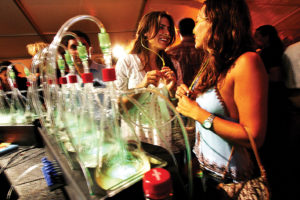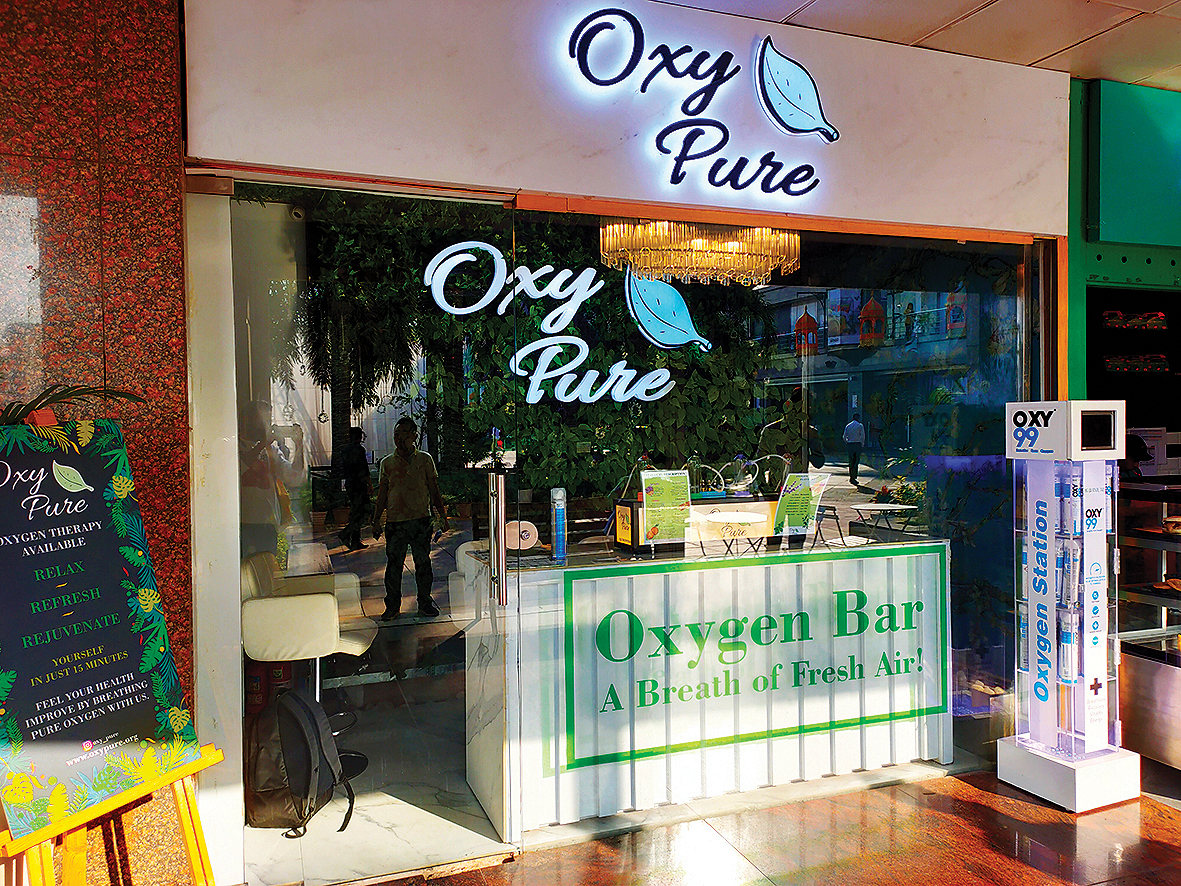When you get tired of inhaling polluted air, try a dose of oxygen to feel rejuvenated — although doctors doubt its therapeutic benefits
No respite is in sight as the Air Quality Index (AQI) in Delhi-NCR continues to jump between ‘severe’ and ‘very poor’ category. While startups are coming up with anti-pollution devices, the Capital city has found a new place to seek respite — ‘Oxy Pure’ — Delhi’s first oxygen bar.
On a Monday afternoon, the influx of people is slow in South Delhi’s popular hangout spot — Select Citywalk Mall. As you enter the mall through the security check, on your left a tiny shop guarded by a glass wall, is seen equipped with a brightly lit station.
“Relax…Refresh…Rejuvenate,” shows a signboard right at the entrance of Oxy Pure. Upon closer observation, a station is seen equipped with an “oxygen concentrating machine”, which purifies the air around it and delivers it to customers.

“Oxygen is infused with several aromas and given to a customer through a nasal cannula (a device used to deliver supplemental oxygen),” says Abhilash, who works at the bar.
The air is not the regular pollution-infused muck you breathe, but “aromatic.” Customers are given options to choose from lemongrass, lavender, cherry, eucalyptus and more.
For each session, which lasts for 15 minutes, customers have to pay Rs 299. Not only this, the bar also has regular customers, who come for some 10 sessions in a month.
Each aroma promises to heal a customer seeking relief from sinus, sleep disorder, indigestion, and even depression.
“Our owner tried this oxygen therapy in Las Vegas. He felt refreshed and liked the concept. So he brought it here,” says Abhilash, upon asking whether a market survey was conducted before the bar opened.
On the two plush high chairs are Ashwin and Nishika, who got to know about the bar through Instagram. Excited to try this new therapy, both came running to the bar.
As the air inflow starts, Nishika is sitting calm and composed, waiting for some instant results. “I can only feel the fragrance of lavender. It’s too strong, this smell. Maybe if it was pure oxygen, then I would’ve felt the difference,” says Nishika.
Sumita, another customer, walks into the bar, and asks for a round. She says she feels short of breath sometimes, due to some problem she’s facing. However, she is pleased with the oils that are used to create aroma while taking the oxygen therapy although she admits, “These oils may or may not work.”
Bonny Irengbam, senior sales assistant, says that the influx of customers is much more than it used to be, due to the severe pollution level in the city.
“We normally inhale 21% of oxygenated air, whether it is polluted or non-polluted air. So it (oxygen) doesn’t drop in the air,” says Dr Bobby Bhalotra.

He continues, “So if you give additional oxygen you are not benefitting anything. If you are a patient of asthma or any lung diseases, you can have complications due to excess oxygen.”
About oxygen inhalation as a therapy, Dr Bhalotra says, “There are no benefits seen so far in the world. That’s the reason FDA doesn’t approve it. So oxygen therapy is a drug therapy used under the supervision of a doctor.”
What about the aromatic flavours used in the oxygen therapy? “These oils they are not recommended medically for direct inhalation…They can trigger asthmatic patients. For normal persons too, you cannot inhale them directly.”
“People will do all kind of things. It is for the regulator to see. In my knowledge, I don’t see any benefits out of this. It is for the regulatory bodies who have given them permission, they have to check on that,” he concludes.
Another interesting thing which takes our attention at the bar is Oxy99, which the company sells as “portable oxygen cylinder,” is an oxygen spray bottle which “instantly increases oxygen levels in the body and helps restore brain and body functions to normal,” as per the claim by the company.
All it takes are 5-6 short bursts to increase the oxygen levels in the body. The company claims its “99% pure oxygen” and works as “first aid vitality recovery.”
Interestingly, Nishika who we met at the Oxy Pure bar, purchased this bottle at Delhi’s airport. “It didn’t do much to me. Plus the quantity is less,” she says.
In a 500 ml can of Oxy99, a customer gets 6 litres of oxygen. On an average, a person consumes 7-8 litres of oxygen per minute. The total would be 11,000 litres per day. The bottle comes off as an expensive affair, even in emergency situations.
Some reviews on e-commerce website Amazon about Oxy99 suggest that the product is in fact a gimmick.
Another product is Pure Himalyan Air which sells the idea of premium air. The company claims that within “2-3 seconds of inhaling the product, you will feel rejuvenated, allowing you to excel and focus on the task at hand.”
One can of Pure Himalyan Air, which costs Rs 550, “cleans the lungs and helps to bring more oxygen to the cells and improves the cleansing action of the lungs,” it is claimed.
While the air we breathe is made up of 21% oxygen, oxygen bars and canned oxygen products claim to give you 95-99% of pure oxygen.
Everydayhealth, a health and wellness website, spoke to Dr Frank LoVecchio, co-medical director at University of Arizona College of Medicine. The doctor says that the products offered in oxygen bars deliver only about 35-40% of oxygen.
One doctor also compared the oxygen therapy at an oxygen bar to the Placebo Effect saying, “It may all be in your head.”
Oxygen bars were introduced in the late 1990s in the United States but under the Federal Food, Drug, and Cosmetic Act, any type of oxygen used by people for breathing and administered by another person is a prescription drug.
While many states in the US choose to allow oxygen bars, others tend to impose strict compliance with the law. The bars dispensing oxygen without a prescription violate FDA regulations.
While the brochure at Oxy Pure says, “You should consult your doctor before trying it,” people coming in huge numbers to try the new fad in the Capital suggest that as the pollution levels are going into ‘severe’ category every now and then, desperation is at play.





